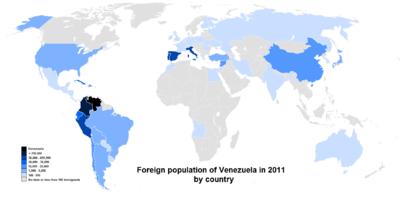Immigration to Venezuela

Immigration to Venezuela has been significant. After the Spanish colonization of the Americas brought some Europeans and some African slaves, immigration to Venezuela was significant particularly in the period after World War II, with large numbers of immigrants from Europe, particularly southern Europe. In addition, Venezuela shares a 1000-mile border with Colombia and has long had substantial numbers of Colombian residents. Since the 1980s, the Colombian conflict has seen largescale Colombian immigration, with Venezuela the number one destination for displaced Colombians: by 2008, there were over 4 million,[1] compared to a total Venezuelan population of around 27 million.
Nineteenth-century immigration
The nineteenth century saw Corsican immigration to Venezuela, with Corsicans playing a substantial role in the cocoa industry. German immigration included the founding of Colonia Tovar in 1843, and German traders played a significant economic role particularly around Maracaibo. By the turn of the nineteenth century and the Venezuela Crisis of 1902–1903, German traders dominated Venezuela's import/export sector and informal banking system.
Caribbean inmigration
Because of the Venezuelan geographical location that welcomes to South America, this nation have been the plot for many new comers, even taking place before Colombus' discovery when lots of aboriginal inhabbitans came and left Venezuela. During the later centuries African-descendants from the Caribbean islands entered Venezuela as inmigrants. Among them Trinidadians, Cubans, Dominicans, Haitians, Dutch Antilleans, Grenadians; in summary people from all the Caribbean nations.[2] To summarize Antillian blacks [3] coming even from British, Dutch and French Guianas.
Haitians in Venezuela
As victims of racism and classism that exists in Venezuela, the Haitian immigration has been neither valued nor documented unlike the European immigration.[4] However, they have left their legacy in the nation of Bolivar. On 24 December 1815 our Liberator first set foot on Haitian soil. Bolivar in 1816 with 400 men all of them Haitians and the freedom cause reach Venezuela. Francisco de Miranda design the first Venezuelan flag in Jacmel (South of Haiti).
The immigration of Haitians can be organized into three phases. The first from the beginning of the 1960s to the beginning of the dictatorship of the Duvalier causing the wave of immigrants to Venezuela. Then, with the "boom" of the Venezuelan economy a greater flow of Haitian nationals entering Venezuela (from the Netherlands Antilles). In mid-1980 the last group enter directly from Haiti, settling down first in Caracas (Carapita, Antímano, San Martin, Catia and La Vega) to exercise duties as ice cream vendors,[5] street vendors, and so on.[6] They are as well in Valencia and Barquisimeto ( San Juan and El Tostao).[7] Many of them trilingual, they speak French, Haitian Creole and Spanish of Venezuela.
Trinidadians in Venezuela
Traditionally located in El Callao region.
Guyaneses in Venezuela
Illegally coming from the Esequibo.[8][9]
Other Antilleans in Venezuela
Many women from West Indian Caribbean came to Venezuela to work at the wealthy American expats who worked at oil fields across Venezuela. Most of them settle in Cabimas, Maracaibo, Socorro among other towns. They were hired because most of those expats refused to learn or speak in Spanish and rejected to hire Venezuela ladies as servants. In this group several English-speaking Grenadian maids came to Venezuela [10]
Post-war European immigration
After World War II, with Eduardo Mendoza Goiticoa in charge of immigration, substantial numbers of immigrants came from Europe, particularly southern Europe. As Secretary of Agriculture for Rómulo Betancourt's government, Mendoza headed the Venezuelan Institute for Immigration and embraced the creation of the International Refugee Organization in 1946 (this body was later replaced by the Office of the United Nations High Commissioner for Refugees). Mendoza succeeded, despite fierce opposition within the cabinet, in ensuring that Venezuela would aid European refugees and displaced people who could not or would not return to their homes after World War II and chose to emigrate to Venezuela. He assumed responsibility for the legal protection and resettlement of tens of thousands of refugees arriving in Venezuela. International Refugee Organization officials consider Mendoza to have directed the most successful refugee program in the post-war period. Immigration reached a peak while he was minister and would later decline with a new government.[11][12]
Spanish immigration
Portuguese immigration
Italian immigration
German immigration
Hungarian immigration
Greek immigration
Polish immigration
Scandinavian immigration
Russian immigration
Ukrainian immigration
Romanian immigration
Swiss immigration
Arab immigration
Lebanese immigration
East Asian immigration
Chinese immigration
Japanese immigration
Korean immigration
North Americans in Venezuela
Mexicans in Venezuela
Canadians in Venezuela
Americans in Venezuela
Since late of the nineteenth century people from United States of America started to come to Venezuela. They were temporary inmigrants. Evangelical missionaries, as well as preachers of other protentant groups, as well as Oil Engineers who came to work in Western Venezuela.[15][16][17][18]
